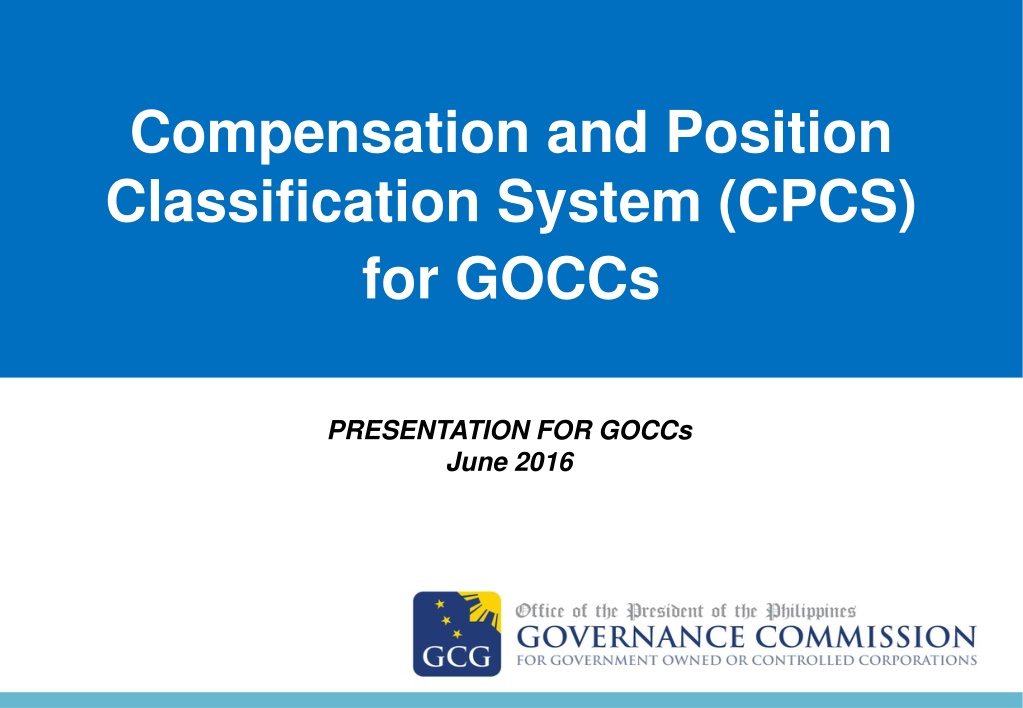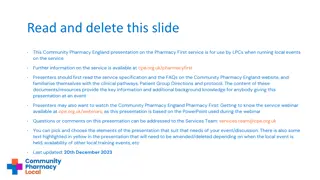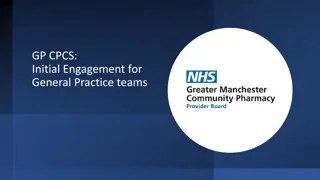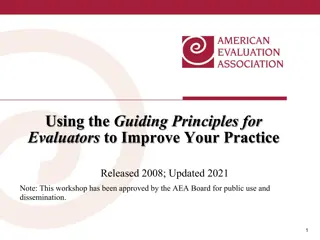CPCS Guiding Principles and Position Classification System for GOCCs
Detailed presentation on the Compensation and Position Classification System (CPCS) designed for Government-Owned and Controlled Corporations (GOCCs), focusing on guiding principles, rewards philosophy, and position classification based on business unit size. Delivered in June 2016.
Download Presentation

Please find below an Image/Link to download the presentation.
The content on the website is provided AS IS for your information and personal use only. It may not be sold, licensed, or shared on other websites without obtaining consent from the author. Download presentation by click this link. If you encounter any issues during the download, it is possible that the publisher has removed the file from their server.
E N D
Presentation Transcript
Compensation and Position Title Classification System (CPCS) for GOCCs PRESENTATION FOR GOCCs June 2016
Slide Title Discussion Agenda CPCS Guiding Principles and Rewards Philosophy Position Classification System a. Business Unit Size b. Career Bands, Career Levels and Job Grades Compensation Items a. Salary Ranges b. Fixed Bonuses and Fixed Cash Allowances c. Performance-Based Bonuses d. Other Items in and beyond the CPCS Implementation Guidelines of the CPCS Communications Planning and Key Messages Job Titles and Typical Qualification Standards 2
Slide Title CPCS Guiding Principles and Rewards Philosophy 3
Background of the Compensation and Position Slide Title Classification System (CPCS) for GOCCs GOCC Governance Act of 2011 (Republic Act 10149), the GOVERNANCE COMMISSION FOR GOVERNMENT-OWNED OR -CONTROLLED CORPORATIONS (GCG) was mandated to: (a) Classify GOCCs; (b) Develop and recommend a competitive compensation and remuneration system which shall: attract and retain talent allow the GOCC to be financially sound and sustainable (c) Develop a COMPENSATION AND POSITION CLASSIFICATION SYSTEM (CPCS) which shall apply to all officers and employees of GOCCs. 4
Slide Title CPCS Guiding Principles 1. Provide GOCCs with adequate operational autonomy and flexibility towards ensuring efficient and effective implementation of a total compensation framework to ensure: (a) The adoption of reasonable, justifiable and appropriate remuneration schemes to prevent or deter the granting of unconscionable and excessive remunerations packages; (b) Generally be competitive with the private sector doing comparable work, and in compliance with prevailing laws on minimum wage; (c) Operate within their affordability limits and sustainability capacities, and in accordance with their overall size as provided herein; (d) Adhere to the principle of equal pay for work of equal value; and (e) The rewards system supports and encourages performance-driven, productive, and efficient organizations. 5
Slide Title Guiding Principles (cont d) 2. The CPCS shall be updated periodically by GCG based on the following: (a) A review of the GOCC compensation rates; (b) The performance of the GOCC and its overall contribution to the national economy; (c) Drastic changes in market or business environment; 3. The CPCS shall cover all positions,on full or part time basis 6
Slide Title Excluded Positions Individuals hired by GOCCs without employer-employee relationships and paid from non-Personal Services appropriations/budgets: (a) Members of the Governing Board; (b) Consultants and experts hired to perform specific activities or services with expected outputs; (c) Laborers hired through job contracts (pakyaw) and those paid on piecework basis; (d) Student laborers and apprentices; (e) Individuals or groups of people engaged through job orders, contracts of service, or others similarly situated. 7
Slide Title Covered GOCCs All GOCCs and their subsidiaries Charted or non-chartered Including those previously exempted from the coverage of the Salary Standardization Law (SSL), Republic Act No. 6758. All GOCCs that are losing and/or highly subsidized in their operations shall maintain their current compensation framework. Such GOCCs may apply with GCG to implement the CPCS, if it can be determined that their operations improve and the GOCC shall remain financially viable 8
Slide Title Excluded GOCCs GOCCs expressly outside the coverage of R.A. No. 10149 Bangko Sentral ng Pilipinas State Universities and Colleges (SUCs) Cooperatives Local Water Districts (LWDs) Economic Zone Authorities Research Institutions 9
Slide Title Position Classification System 10
Classifications of GOCCs Slide Title (Under R.A. No. 10149 and E.O. No. 203) To ensure that GOCCs are aligned with rates and practices of private sector entities doing comparable work By Sector 1. Government Financial Institutions (GFIs) and Gaming 2. All Other Sectors Energy and Materials Utilities and Communications Area Development, Trade and Tourism Agriculture, Fisheries and Food Educational and Cultural By Overall Size - each GOCC shall be compared or benchmarked with private sector entities similar in size in terms of finances and operations 11
Slide Title Position Classification Process Determine the Size of the Organization (to be done by GCG based on data submitted by GOCCs) Grade of the organization based on: a. Company financials b. Number of full time equivalent (FTE) employees c. Geographical scope and Business Complexity/Diversity Determining the Band of the Job Nature of contribution Level of Contribution Determining the Career Level and Job Grade The size of the organization determines the number of Job Grades a GOCC may have. It also impacts the Job Grades of Jobs in the Executive Band of the CPCS. 12
Step 1: Determining Size of the Organization Slide Title CLASSIFICATION OF GOCCS BY OVERALL SIZE. For purposes of the CPCS, GOCCs are classified in accordance with their overall size determined by getting the average of the following three (3) factors: (a) Company Financials; (b) Number of Full-Time Equivalent (FTE) Employees; and (c) Geographical Scope and Business Complexity. If the resulting average grade is a decimal number, the figure shall be rounded off to the nearest whole number for the GOCC s overall grade / size as categorized below: CLASSIFICATION AVERAGE GRADE 16 Small 17 to 18 Medium 19 and Up Large The classification shall be based on an official certification issued by GCG, covered by supporting instruments and documents. GCG may change a GOCC s classification 13
Step 1: Determining Size of the Organization Slide Title 2. Number of FTE Employees. GOCCs shall have a grade based on the number of FTE Employees as follows: 1. Company Financials shall be based on the average of the prior three (3) years audited financial statements; GOCC GRADE CONVERSIONC/O GCG) 16 < 3.0 billion 17 > 3.0 billion and < 6.5 billion 18 > 6.5 billion and < 22.0 billion 19 > 22.0 billion and < 43.5 billion 20 > 43.5 billion and < 87.5 billion 21 > 87.5 billion and < 218.0 billion 22 > 218.0 billion and < 436.5 billion 23 > 436.5 billion and < 2.0 trillion 24 > 2.0 trillion and < 4.0 trillion 25 > 4.0 trillion GOCC GRADE 16 17 18 19 20 21 22 23 24 25 FINANCIAL RANGE (P) (USD TO PHP NO. OF FTE EMPLOYEES Up to 89 90 to 240 241 to 620 621 to 1,600 1,601 to 4,100 4,101 to 10,600 10,601 to 27,500 27,501 to 75,000 75,001 to 200,000 More than 200,000 *The computation of Company Financials will be done by GCG in consideration of the operations and mandates of each GOCC. * Consider the approved headcount in the plantilla of the approved organizational structure 14
Step 1: Determining Size of the Organization Slide Title 3. Geographical Scope and Business Complexity. The grade for the GOCC s Geographical Scope and Business Complexity shall be determined as 3.1 Geographical Scope GEOGRAPHICAL SCOPE Global 20 22 24 International 19 21 23 Domestic 16 18 20 Low Medium High BUSINESS COMPLEXITY Geographical Scope. (a) Domestic if majority of operations are based in a single country or a small cluster of countries within one region (b) International if the organization is characterized by multi-function operations across an entire region or in several countries in two continents. (c) Global if the majority of functions are represented across three or more continents. All GOCCs are automatically classified as domestic unless there is clear and substantial basis to classify the GOCC s actual operations otherwise. 15
Step 1: Determining Size of the Organization Slide Title 3. Geographical Scope and Business Complexity. The grade for the GOCC s Geographical Scope and Business Complexity shall be determined as: 3.2. Business Complexity assumes that the GOCC Governing Board has end to end control of the business CATEGORY DESCRIPTION Low GOCC s operations involve only one of the activities specified below. Medium GOCC s operations involve only two of the activities specified below. High GOCC s operations involve all three of the activities specified below. The three types of activities considered: i. Regulatory; and/or ii. Revenue-Generation; and/or iii. Social Services 16
Step 2: Determine the Career Band of the Job Slide Title The CPCS Position Classification differentiates jobs on both their nature and level of contribution to the organization CPCS POSITION CLASSIFICATION MAP MANAGEMENT TRACK CONTRIBUTOR TRACK INDIVIDUAL 17
Step 2: Determine the Career Band of the Job Slide Title Typically, one downs of CEO/President/Business Unit Heads Primarily involved in the development, evolution and approval of long- term vision across a market function, division, region or country Impacts broader organization performance directly Main focus is on strategy setting (with Org-wide impact) Executive (EX) Implements organization strategies through the effective direction and management of resources Sets discipline or area strategy consistent with established organization strategies Focused on policy making and/or implementation Accountable for managing people, setting direction and deploying resources Supervisory/ Management (M) Primarily involved in direct contact with clients to acquire new business or develop existing accounts Participates in sales presentations, developing bids, and responding to proposals At senior levels, likely to set/negotiate product/service terms A portion of their compensation is likely to be based on sales results Customer/Client Management & Sales (S) 18
Step 2: Determine the Career Band of the Job Slide Title Work is primarily achieved by an individual or through project teams Qualified professionals who are expected to use their judgment to apply expertise gained through education and/or experience Progression within the career band is defined by increasing depth of professional knowledge, project management, and ability to influence others Typically requires mastery of a specialized field of expertise related to professional qualification which may be in the form of a professional certification (e.g., Engineers, CPA, etc.) Professional (P) Performs technical tasks required to support on-going business operations (e.g., Technicians, IT Administrators) Requires vocational training or the equivalent experience, but does not require a university degree Skilled technician in a hands-on environment, often highly specialized Technical Support (T) 19
Step 2: Determine the Career Band of the Job Slide Title Supports the business through performing clerical/administrative support tasks Work is typically rule-based, covered by standard operating procedures, and jobholder has very limited opportunity to deviate from agreed processes and standards May require vocational training or the equivalent experience, but does not require a university degree General Staff (G) Performs operational, craft or manual tasks Performs tasks according to established procedures, with limited opportunities for independent decision-making Typically performs unskilled or semi-skilled work Labor (L) 20
Step 3: Determining the Career Levels and Job Slide Title Grade CPCS POSITION CLASSIFICATION MAP MANAGEMENT TRACK CONTRIBUTOR TRACK INDIVIDUAL 21
Slide Title Sample Output of Job Leveling The Position Classification Matrix allows for easier review of the alignment of jobs vertically in the same function/unit, and across units/functions. CAREER LEVEL M4: Grp Mgr JOB GRADE 16 ACCOUNTING AUDIT LEGAL LEGAL COUNSEL (M4) M3: Sr Mgr 15 ACCOUNTING MANAGER (M3) CONTROLLER (M3) ACCOUNTING ASSISTANT MANAGER (M2) CONTROLLERSHIP SUPERVISOR (M2) AUDIT MANAGER (M3) M2: Mgr 13 AUDIT SUPERVISOR (M2) ACCOUNTING SUPERVISOR (M2) FINANCIAL ANALYST (M1) P3: Career 11 SENIOR AUDITOR (P3) M1: Supv 22
Slide Title Compensation Items 23
Slide Title Compensation System in the CPCS The total compensation granted shall include: Basic Salaries Standard Allowances and Benefits Specific-Purpose Allowances and Benefits Variable Pay Excluded are indirect compensation regulated under existing laws Life and retirement insurance benefits Employee compensation insurance Health insurance Pag-IBIG fund benefits Provident Fund benefits There will be non-diminution of the authorized amount of monthly basic salary as of December 31, 2015 for incumbent employees 24
Basic Monthly Salaries: Slide Title Developing the Salary Ranges Classified the GOCC jobs Using CPCS Defined the guiding principles of the CPCS Conducted cash competitive Analysis Developed salary ranges 25
Basic Monthly Salaries: Slide Title Difference between SSL and CPCS FROM TO CPCS Salary Ranges Job Grades 1 to 11: Single Salary Ranges Job Grades 12 and above: Salary Ranges differentiated according to Sector a. Government Financial Institutions (GFIs) and Gaming b. All Other Sectors SSL-covered GOCCs SSL-exempt GOCCs SSL: 33 salary grades, CPCS pay structure identifies a Minimum and Maximum pay for each job grade 8 steps per grade 26
Salary Ranges Slide Title Job Grades 1-11 Current SSL Fourth Tranche Monthly Salary Schedule CPCS Salary Ranges Job Grade Minimum Maximum 1 2 3 4 5 6 7 8 9 11,068 11,761 12,466 13,214 14,788 16,548 18,519 20,754 25,947 32,440 40,558 11,756 12,461 13,209 14,787 16,547 18,518 20,722 25,946 32,439 40,557 50,702 10 11 Reference date of Salary Ranges is as of January 1, 2016. Salary Ranges are typically reviewed every 2-3 years. GCG shall periodically update the CPCS based on parameters outlined in the EO. 27
Salary Ranges Slide Title Job Grades 12 and above CPCS Salary Ranges GFIs and Gaming Current SSL Fourth Tranche Monthly Salary Schedule Job Grade Minimum Maximum 12 13 14 15 16 17 18 19 20 21 53,814 73,186 99,534 138,897 180,567 238,579 322,081 434,809 591,339 804,221 All Other Sectors Minimum 55,652 72,348 94,052 124,985 156,231 195,289 244,111 310,446 403,579 524,653 73,186 99,534 135,366 180,566 234,736 322,080 434,808 586,991 798,307 1,085,699 Job Grade 12 13 14 15 16 17 18 19 20 21 Maximum 72,348 94,052 122,268 156,231 195,289 244,111 305,139 403,579 524,653 682,049 28
Standard Allowances and Benefits Slide Title (Fixed Bonuses and Allowances) These items are given across-the-board based on the prescribed rates in line with the private sector practice Shall include the following: All Sectors Type Annual Amount 1.00 x Monthly Pay Mid-Year Bonus (13th month) Year-end Bonus (14th month) Rice Clothing Meal Fixed Bonus 1.00 x Monthly Pay Php 16,000 Php 6,000 Php 18,000 Fixed Cash Allowances 29
Design Principles of Variable Pay: Slide Title Performance-Based Bonus Systems Parameters and considerations in designing the PBB A. Individual Performance-Based Bonus (IPBB) Linked to individual performance Target amount differs depending on Job Grade B. Organizational Performance-Based Bonus (OPBB) Linked to organizational performance Target amount is 1.0 monthly basic salary for all 30
Elements of the Individual Performance- Slide Title Based Bonus (IPBB)* Element Provisions Officers and Employees who occupy regular positions Should have rendered at least six (6) months of service in the GOCC for the performance year Targeted PBB payout should be included in the payroll expense budget for the coming year plus a buffer of 10% If unspent, the amounts shall revert as savings for the GOCC The budgeted amount shall also take into consideration the affordability constraints of the GOCC Overall Organization Performance Individual performance Eligibility Plan Funding Performance Measures Payout Criteria Pursuant to the Performance Evaluation System for the GOCC Sector (GCG MC No. 2013-02): - Achieve a weighted-average score of at least 90% on its Performance Scorecard - Comply with the Good Governance Conditions prescribed by GCG *The IPBB is separate from the Organizational Performance-Based Bonus (OPBB) **GCG shall issue Memorandum Circulars on the implementation of the various PBB systems. 31
Elements of the Individual Performance- Slide Title Based Bonus (IPBB)* (cont d) Element Provisions Individual performance measured by the GOCC s Strategic Performance Management System (SPMS) or equivalent Ratings shall be quantified to allow for ranking based on the following performance brackets. Labor, General Staff, Technical Support bands (JG 1-7) Client Management/Sales, Professional, Management/Supervisory bands (divided into JG 8-11, and JG 12-15) Executives (JG 16-21) Target payout for each performance bracket, expressed as a multiple of monthly base salary: Calibration between Measures & Awards Performance Category JG 1-7 JG 8-11 JG 12-15 JG 16-21 Top 10% 1.50 2.00 2.50 3.50 Next 25% 1.25 1.75 2.25 3.25 Remaining 65% 1.00 1.50 2.00 3.00 None None None None Below Satisfactory Performance period to follow the calendar year Annual payout, generally during the first half of succeeding year Performance Period and Payout Frequency 32 Based on monthly basic salary Amount
Individual Performance-Based Bonus (IPBB): Slide Title Illustration Step 1: Evaluate GOCC performance Yes No No GOCC hits target? Pay-Out X Rank employees Step 2: Rank eligible employees according to performance Performance Category Top 10% Next 25% Remaining 65% JG 1-7 JG 8-11 JG 12-15 JG 16-21 1.50 1.25 1.00 None 2.00 1.75 1.50 None 2.50 2.25 2.00 None 3.50 3.25 3.00 None Below Satisfactory 33
Elements of the Organizational Performance- Slide Title Based Bonus (OPBB)* Element Provisions All officers and employees of the GOCC Eligibility Overall Organizational Performance Performance Measures Payout Criteria Certification by GCG that a GOCC has achieved a weighted-average score of at least 90% on its Performance Scorecard for the previous year Performance period to follow the calendar year Annual payout in the first quarter of each year Performance Period and Payout Frequency Amount Others One month s (1.00) basic salary The administration of the OPBB shall follow the same relevant criteria and processes pertaining to the IPBB, as covered in the EO *The OPBB is separate from the Individual Performance-Based Bonus (IPBB) **GCG shall issue Memorandum Circulars on the implementation of the various PBB systems. 34
Slide Title Other Compensation Items in the CPCS Standard Benefit Healthcare Plan The Governing Board of a GOCC may, subject to guidelines to be issued by GCG, procure a Healthcare Plan supplementing benefits received under PhilHealth The plan may include the following Benefits: Hospitalization Benefit Clinical/Outpatient Benefit Dental Care Optical Benefit And others. GOCC must be financially capable of sustaining services of the Healthcare Plan Procurement is subject to RA 9184 (Government Procurement Reform Act) 35
Slide Title Other Compensation Items in the CPCS Specific-Purpose Allowances and Benefits Hazard Pay for personnel exposed to hazardous situations Overtime pay for Technical Support, General Staff and Labor Bands Night-Shift Differential Pay Honorarium for individuals concurrently occupying a Board/Corporate Officer position Allowance for lawyer-personnel appearing in court hearings Other allowances and Benefits peculiar to certain GOCCs (subject to GCG s approval) Variable Pay Anniversary Bonus Productivity Enhancement Incentive (PEI) 36
Slide Title Other Compensation Items in the CPCS CNA Incentives, to be extended to cover non-Chartered GOCCs in addition to Chartered GOCCs (governed by policies of DBM) Incentives allowed by CSC (e.g. Program on Awards and Incentives for Service Excellence) The GCG may recommend, for the President s approval, incentives outside of the CPCS for certain position titles in consideration of the good performance of the GOCC. Early Retirement Incentive Plan (ERIP) for officers and employees covered by CPCS who voluntarily elect to be retired or separated. GOCCs must undergo reorganization under GCG in order to offer this, but do not need to have implemented CPCS. Government Service Rates* (based on current salary, not on CPCS rates) First 20 years 1.00 * Basic Monthly Pay * No. of years 20 years and 1 day to 30 years 1.25 * Basic Monthly Pay * No. of years 30 years and 1 day and above 1.50 * Basic Monthly Pay * No. of years 37
Slide Title Implementation of the CPCS 38
Slide Title Role of the GOCC 1. Each covered GOCC shall adopt a Total Compensation Framework (TCF), subject to the approval of the President of the Philippines in accordance with the favorable recommendation of the GCG. If no action is taken by the Office of the President within 45 days of receipt, the same shall be deemed approved unless the Office of the President informs the GCG otherwise. 2. Implementation of compensation adjustments shall depend on the financial capability of the GOCC and their Corporate Operating Budget as approved by GCG, and those approved by the DBM for entities receiving allocations for the National Government 3. Basic Salaries if there are affordability concerns, the GOCC may propose a salary range for each Job Grade that falls below the salary ranges prescribed in the EO, taking into account the financial standing of the GOCC as well as the sustainability of the compensation framework. 39
Slide Title Implementing the Salary Ranges The implementation of the CPCS is progressive, not retroactive Hiring Rate guidelines For JG 1-11 May be set up to minimum during the probationary period, but in no case lower than the applicable minimum wage rate mandated by law. Upon appointment to regular status, pay may be increased to the minimum For individuals who exceed the minimum CSC Qualification Standards, the hiring rate may be set until 5% above the minimum of the salary range For JG 12 and above The hiring rate may be set up to 10% above minimum if the individual exceeds the minimum CSC Qualification Standards (e.g. graduation from a reputable school, relevant experience, having more than the required educational attainment) 40
Slide Title Implementing the Salary Ranges Promotion the Governing Board through Management may promote individuals through: 1. Raise the salary to the minimum of the Job Grade of the vacant plantilla item which the employee will be promoted to Job Grade Minimum Maximum 4 5 13,214 14,788 14,787 16,547 Example: Current Job: Grade 4, with Salary of Php 14,000 Promotion to Job Grade 5, with a minimum of Php 14,788 Raise raise pay to Php 14,788 41
Slide Title Implementing the Salary Ranges Promotion (continued) 2. If the employee s salary already exceeds the minimum of the Job Grade of said plantilla item, raise the salary by the percentage difference in the salary range minimum of the current Job Grade to the new Job Grade Job Grade Minimum Maximum 4 5 13,214 14,788 14,787 16,547 Example: Current Job Grade 4, with Salary of Php 14,800 Promoted to Job Grade 5, with a minimum of Php 14,788 Compute for the percentage difference of the minimums (Job Grade 5 Job Grade 4)/Job Grade 4 = (14,788 13,214)/13,214 11.91% Raise salary by 11.91% = 14,800 * (1 + 11.91%) = 16,563. Promotion increases cannot exceed the maximum of the new Job Grade; hence the new salary is capped at 16,547 42
Slide Title Implementing the Salary Ranges Promotion (continued) 3. Raise the salary by the percentage difference in the salary range midpoints of the current Job Grade to the new Job Grade Job Grade Minimum Maximum 4 5 13,214 14,788 14,787 16,547 Example: Current Job Grade 4, with Salary of Php 14,800 Compute for Midpoint = (Minimum + Maximum)/2 Job Grade 4 = (13,214 + 14,787)/2 = 14,001 Job Grade 5 = (14,788 + 16,547)/2 = 15,668 Compute for percentage difference = (15,658-14,001)/14,001 = 11.91% Compute for the new salary = (14,800 * (1+11.91%) = 16,562 Promotion increases cannot exceed the maximum of the new Job Grade; hence the new salary is capped at 16,547 4. If the employee moves from an overtime-earning job to a non-overtime earning job, consider the earning potential lost 43
Slide Title Implementing the Salary Ranges Merit Increases in order to support a performance-driven organization, GOCCs may recommend merit increases subject to GCG s approval: Step 1: Determine the salary increase budget for the year. Consider projected market salary increase and the GOCC s affordability to pay Step 2: Determine the performance rating distribution under the GOCC s Strategic Performance Management System (SPMS) or equivalent. Implementing guidelines may vary year-on-year depending on considerations such as budget. The table below shows the recommended distribution of the GOCC s population: Performance Rating Recommended Distribution 10% of employees 20% 50% 15% 5% Outstanding Very Satisfactory Satisfactory Unsatisfactory Poor 44
Slide Title Implementing the Salary Ranges Merit Increases (continued) Step 3: Allocate percentage increases depending on individual performance. The following additional factors may be considered Current position in the salary range Rate of progress and future potential (increase the time interval and/or decrease size of increase for individuals approaching what appears to be the ultimate potential) Foreseeable promotion opportunities Salary increase budget The Governing Board through Management may withhold unearned increases from a poor performer where appropriate In no case shall implementation of a merit increase result in raising the current salary of an individual above 25% of the maximum for his/her job 45
ILLUSTRATION: Slide Title Implementing the Salary Ranges Sample Merit Increase matrix considering both position in range and individual performance Performance Position in Salary Range Bell Curve Distribution Rating Below Minimum Minimum to 1/3 of Maximum 1/3 to 2/3 of Maximum 2/3 of Maximum to Maximum 8.25% 5.00% 3.25% 1.75% Above Maximum 10.50% 6.50% 4.00% 3.25% 9.75% 6.00% 3.75% 2.75% 9.00% 5.50% 3.50% 2.25% 7.50% 4.50% 3.00% 1.25% 10% 40% 40% 10% 4 3 2 1 Using the two-dimensional matrix is aligned to the pay philosophy of considering both individual performance and competitiveness against the market. 46
Slide Title Communications Planning and Key Messages 47
Slide Title Communication Management Objectives General Objective: To identify the appropriate messages for respective audiences to be delivered through effective communication channels To equip the communication core team on change and communication management for the CPCS Specific Objectives: To identify and understand the key stakeholders and their current perceptions about the change To identify key messages and communication channels to implement the CPCS To create communication toolkits to provide select communication and change champions to deliver the messages 48
Slide Title Role of Communication Core Team Advocate of change. Assist in explaining and providing context on CPCS Link. Bridge the gap between the employees and management and/or GOCCs and GCG Listen to what employees say about CPCS Observe how employees react, feel about the changes Act Document feedback received Provide feedback to Core Team and/or GCG on the concerns received and observations noted Address questions or misperceptions Direct questions or misperceptions to the right party Participate in communication management meetings and brainstorm on interventions Support GCG in addressing or articulating the responses to issues / questions raised 49
An effective Communication Strategy Slide Title supports the Change Initiative Targeted, measurable objectives and the specific strategies needed to achieve success Objectives Who needs to know when and, for key communicators, what their role is in the process Audience Analysis Critical messages that become the touchstone for the entire communication process Key Messages Channels Plan Using the right channel for specific communication interventions Timing Delivering messages in a timely, thoughtful and integrated way Success Measures Guidelines for success and methods of data-gathering 50























